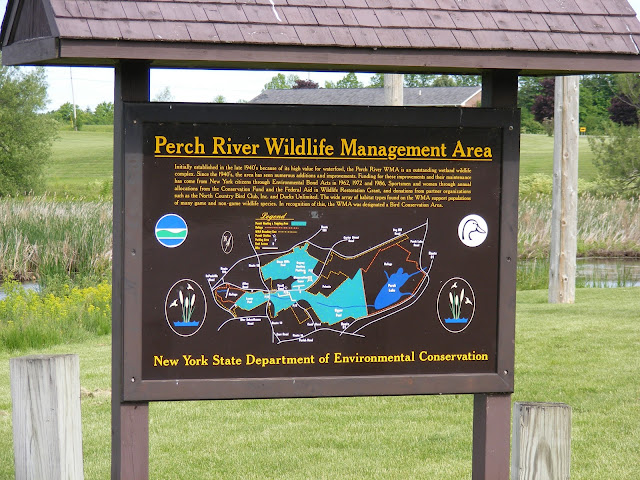The Hudson-Mohawk Bird Club conducted an overnight field trip to Perch River WMA near Watertown, NY on Sat., May 25th- Sun., May 26th. We escaped rainy, windy, very cool weather in the Capital District, but the conditions were only marginally better at our destination. At least there was no rain. Some of the participants stopped at Tug Hill WMA southwest of Lowville in Lewis County on the way up Saturday, then moved up to Chaumont Barrens Preserve early in the afternoon.
It was windy and cool at Tug Hill WMA. We were hoping to see some of the woodland songbirds and warblers that breed on the plateau, but the birds had other ideas. Chestnut-sided Warbler put in an appearance, but only a few other species could be heard in the distance. Mourning Warbler, our target species, which usually can be easily observed there, was absent. We decided to leave early and devote more time at our other two Day One stops.
65 acre impoundment at Tug Hill Wildlife Management Area (click to enlarge)
active Osprey nest on Morris Tract Rd., Chaumont (click to enlarge)
Chaumont Barrens Preserve is one of the last and finest examples of alvar grasslands in the world, and is a link in the chain of North American alvars forming an arc from Jefferson County through Ontario, and all the way to northern Michigan.
Chaumont Barrens Preserve, protected by The Nature Conservancy (click to enlarge)
The soil layer is very thin, covering limestone underneath, which is exposed in places. Many of the plants are unique to this habitat, and others are stunted versions of species seen elsewhere, especially the evergreens.
trail at Chaumont Barrens (click to enlarge)
It was early afternoon, so things were fairly quiet at the Barrens, but we saw singing Great Crested Flycatchers, Field Sparrow, an Eastern Kingbird, a Brown Thrasher, and a handsome Black-and-white Warbler. We could also hear our target species, Golden-winged Warbler, in two different places, but they remained out of sight range.
We met the other members of our group at Perch River WMA, which is located about eight miles to the northwest of Watertown. It is some 8,000 acres of high quality wetlands bordered by deciduous forest, shrubland, and open agricultural fields.
main parking area at Perch River WMA along Rt. 12 (click to enlarge)
Caspian Tern flyby (click to enlarge)
We birded Perch River for two hours Saturday afternoon, and for three hours the next morning. Highlights included three American Bitterns in the grassy field below the observation tower near the Stone Mills Pool, Black-crowned Night-Herons, Pied-billed Grebes, many Osprey, a Wilson's Snipe, Caspian Terns, and many Black Terns flying back and forth between the Upper and Lower Pools.
Perch River map, including the refuge areas (click to enlarge)
view of the Upper Pool, Perch River WMA (click to enlarge)
view of the Lower Pool at Perch River WMA (click to enlarge)
Marsh Wren foraging just above the water (click to enlarge)
Black Tern soaring above the Lower Pool (click to enlarge)
On Sunday afternoon, a few of the participants returned to Chaumont Barrens to attempt to visually observe the Golden-winged Warblers. After ninety minutes of moving back-and-forth, to-and-fro, here-to-there-and-back, we finally nabbed the little bugger. Getting a good visual can be important with winged-warblers, as the two species can interbreed and produce variably plumaged and voiced offspring.
information kiosk at Chaumont Barrens (click to enlarge)
limestone fissure, watch your step (click to enlarge)
cephalopod fossil in limestone (click to enlarge)
Alvar landscape (click to enlarge)
Prairie Smoke and grasses (click to enlarge)
Chaumont Barrens (click to enlarge)
Golden-winged Warbler behind branch (click to enlarge)
Golden-winged Warbler behind pine needles, center (click to enlarge)
Field of Prairie Smoke at Chaumont Barrens Preserve (click to enlarge)
TW





























































